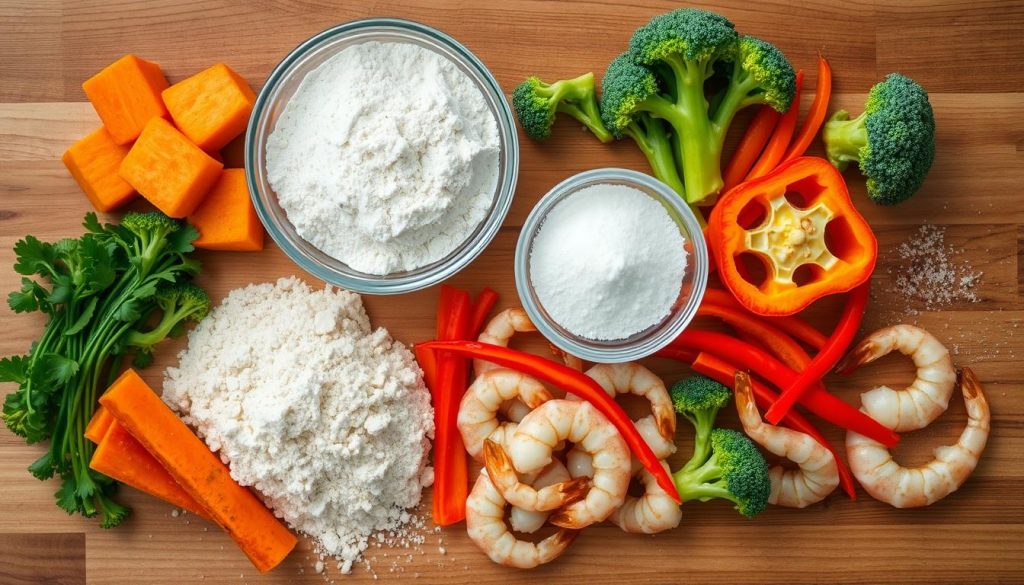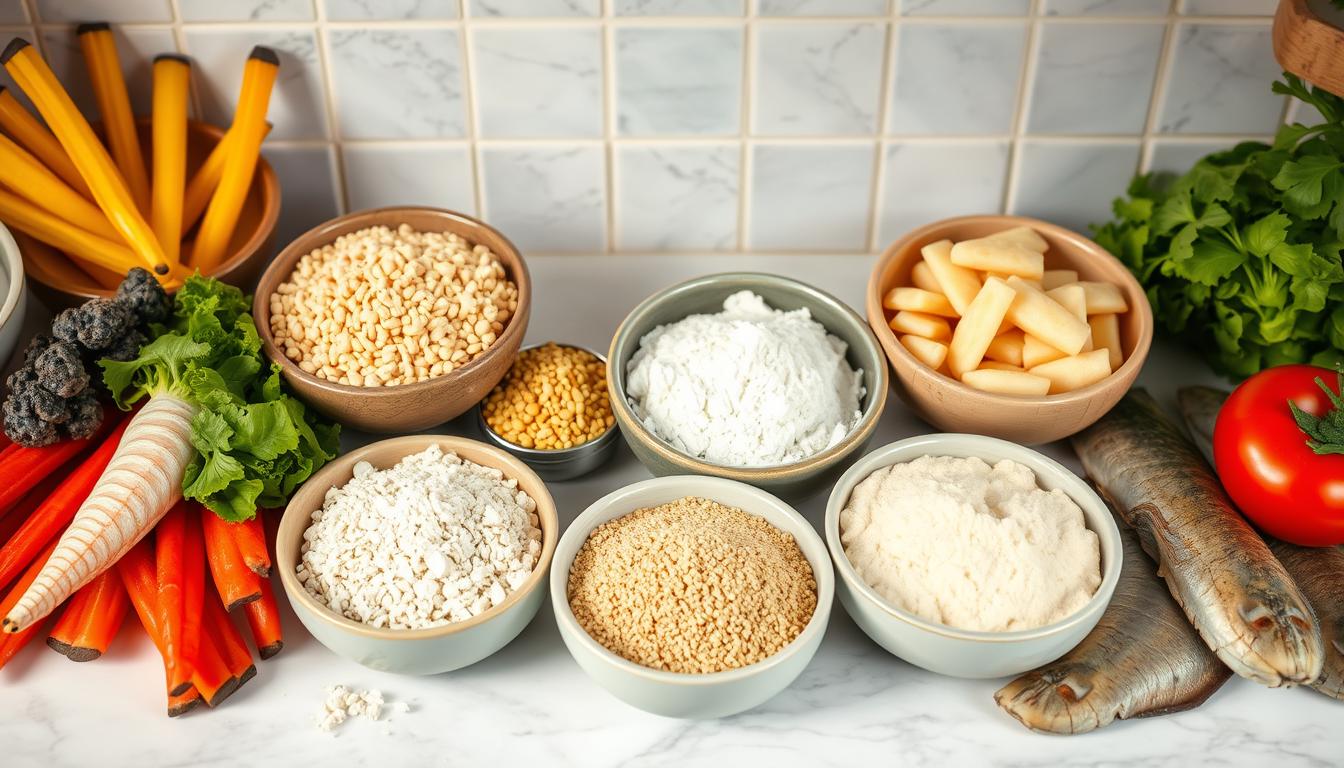If you want to make crispy tempura at home but lack traditional tempura flour, this guide is for you. Tempura, a beloved Japanese dish, is known for its light and crunchy texture. This comes from a special mix of ingredients.
This article will show you alternatives to traditional tempura batter. You’ll find tips and homemade recipes to get that signature crunch. It’s perfect for those with dietary restrictions or when ingredients are hard to find. You’ll learn how to make your tempura crispy and delicious.
Introduction to Tempura and Its Traditional Flour Use
Tempura is a favorite in Japanese food, known for its light, crispy batter. Its tempura history started in the 16th century with Portuguese missionaries. They introduced frying battered foods to Japan, which quickly became popular, especially in Nagasaki.
Traditionally, tempura uses simple ingredients like low-protein wheat flour, egg, and iced water. The right traditional tempura flour is key to its airy texture. This flour choice lets the dish’s natural flavors stand out while keeping the outside crispy.
Tempura often includes seafood and vegetables. Shrimp Tempura, made with Japanese tiger prawns, is the most loved. Other seafood like abalone and cod, along with vegetables like asparagus and sweet potato, are also favorites.
Tempura is a mix of European and Japanese cooking. It’s famous for its simple batter, which lets the ingredients’ true taste shine. The batter’s lightness comes from a 1:1 flour-to-water ratio and being kept cold. This makes tempura a treat that’s both tasty and deeply rooted in Japanese cuisine.
What is Tempura?
Tempura is a cooking method that involves battering and deep-frying ingredients like vegetables and seafood. It creates a crispy texture and brings out the flavors of the ingredients. This technique comes from Japanese cuisine, introduced by Portuguese missionaries in the 16th century.
Common ingredients in tempura, called “tane,” include shrimp, sweet potatoes, and eggplant. Each adds its own taste and texture. The batter, made from flour and water, can also include eggs or sparkling water for extra lightness.
There are many types of tempura, from vegetable dishes to those with fish and meat. Its versatility makes it a favorite among many. You can enjoy it with just salt or with dipping sauces, which add to the flavors of the ingredients.
Why Consider a Tempura Flour Substitute?
When making tempura, finding tempura flour substitutes is key for many reasons. One big reason is dietary needs. People with gluten intolerance need gluten-free options that still taste like traditional tempura. Trying new ingredients can also lead to tasty and different flavors and textures.
Trying out different ingredients can spark your creativity in the kitchen. You can use rice flour and potato starch, which are gluten-free and make a lighter batter. Each one adds its own special touch to your dish.
Want to try new things in cooking? Learning about different flours can help you make tasty tempura that fits your diet. With the right tempura flour substitutes, you can make a delicious meal that’s also healthy.
| Substitute | Benefits | Best Use |
|---|---|---|
| Rice Flour | Gluten-free, light texture | Gluten-free tempura batter |
| Potato Starch | High crispiness, neutral flavor | Coating for vegetables and proteins |
| Sweet Rice Flour | Chewy texture, naturally sweet | Japanese desserts and specialty tempura |
| All-Purpose Flour | Versatile, accessible | Traditional tempura |
| Barley Starch | High fiber, unique flavor | Fusion cooking and experimental dishes |
Common Ingredients in Tempura Flour and Their Roles
Tempura flour has several key tempura flour ingredients. Low-protein wheat flour makes the batter light. Cornstarch helps keep it crispy by absorbing moisture. Rice flour adds a special texture.
Keeping ingredients cold is important. Ice water in the batter keeps it right. This helps the batter stay airy and crispy.
A traditional tempura batter is simple: flour, egg, and ice water in equal parts. Stir it gently with chopsticks for 15 to 20 seconds. This avoids making the batter tough. Fry in oils like sesame or canola to keep it crispy.
For fluffier tempura, you can add baking soda or sparkling water. It takes 2 to 3 minutes to fry each side to golden brown. Knowing how these ingredients work helps you fry better. You can try frying shrimp, veggies, and more.
| Tempura Flour Ingredient | Role |
|---|---|
| Low-protein Wheat Flour | Creates a light batter texture |
| Cornstarch | Enhances crispiness, moisture absorption |
| Rice Flour | Adds unique texture |
| Ice Water | Slows gluten formation, prevents oil absorption |
| Baking Soda/Sparkling Water | Promotes fluffiness, enhances batter lightness |

Tempura Flour Substitute Guide
Want to make tempura without the usual flour? Making your own substitute is a great idea. This guide shows you how to make homemade tempura flour and suggests other flours for a crispy texture.
Homemade Tempura Flour Recipe
To make homemade tempura flour, mix 1 cup of all-purpose flour with 2 tablespoons of cornstarch. This combo makes it extra crispy. For a gluten-free version, use rice flour, cornstarch, and sparkling water. You can adjust the mix to get the perfect texture for your tempura.
Alternative Flours for Crispy Tempura
There are many flours that can make your tempura crispy without using traditional flour. Here are some:
- Whole Wheat Flour: Use up to 50% of all-purpose flour for a nutty taste and more nutrition.
- Quinoa Flour: It’s a complete protein and great for health-conscious eaters.
- Oat Flour: Made from gluten-free oats, it adds soluble fiber to your batters.
- Almond Flour: Low in carbs and full of Vitamin E, it’s good for paleo and gluten-free diets.
- Brown Rice Flour: High in fiber, it’s perfect for tempura and quick breads.
- Coconut Flour: Low in carbs, it needs more moisture but’s great for Keto and Paleo.
- Chickpea Flour: High in protein and gluten-free, it’s great for savory dishes like tempura and veggie burgers.
- Spelt Flour: Mix it with all-purpose flour in a 3:1 ratio for more flavor and fiber.
- Buckwheat Flour: Gluten-free, it can replace all-purpose flour one-to-one, perfect for soba noodles.
- Amaranth Flour: It has a nutty flavor and can replace about 25% of wheat flour.
With these flours and recipes, you can enjoy crispy tempura, no matter your diet. Trying different flours makes cooking more fun and adds new flavors and textures to your meals.
Tips for Achieving the Perfect Crispy Texture
To get the perfect crispy texture in your tempura, you need to focus on a few key things. First, make sure your oil is hot before you add the batter. The ideal frying temperature is between 340°F and 375°F. This temperature is crucial for that crunchy texture you love.
Importance of Temperature for Crispiness
The temperature of the oil is key to the texture of your tempura. When the oil is around 350°F, it makes the batter puff up quickly. This gives you that crispy outside everyone wants. Use oils with high smoke points, like sesame oil, to prevent smoking. Keeping the oil at a steady temperature is also important. If the temperature changes, your tempura might not cook evenly, which can ruin the crispiness.
How to Mix the Batter Effectively
When mixing the batter for tempura, aim for a lumpy texture. Use equal parts flour, egg, and cold water. Adding cold water and sparkling water or ice cubes helps keep the batter light. Avoid overmixing, as it can make the batter dense. By following these tips, you’ll get a light and fluffy batter that’s perfect for all sorts of ingredients.

| Factor | Ideal Measurement |
|---|---|
| Frying Temperature | 340°F – 375°F |
| Flour to Egg & Water Ratio | 1:1 |
| Initial Frying Time | 30 seconds |
| Additional Frying Time | 2.5 minutes |
Options for Gluten-Free Tempura Flour Substitutes
Looking for gluten-free tempura options? You have many choices that keep the crispiness. A mix of rice flour and cornstarch is a top pick for a light batter. Chilling your ingredients before frying makes them even better.
Using Rice Flour and Cornstarch
For a perfect batter, try ¾ cup of rice flour and ½ cup of cornstarch. This combo gives a crispy finish like traditional tempura. Adding a pinch of turmeric or paprika can also boost the taste of your rice flour tempura.
Other Gluten-Free Combinations
There are more gluten-free flour options like potato starch, cassava flour, and chickpea flour. Each one adds something special to the batter. You can play with different ratios to find your favorite. Mixing these flours makes your gluten-free tempura not only tasty but also healthier.
Conclusion
This guide has given you a deep dive into tempura flour alternatives and key cooking techniques. Choosing the right flour is key, but don’t forget: getting that perfect crispy texture is all about your cooking skills. A well-balanced batter, with the right mix of flour, egg, and water, is usually 1:1. This mix ensures your tempura is light and crispy.
Trying out homemade flours or gluten-free options like rice flour and cornstarch can open up new flavors. Remember, the key to great tempura is not to overcrowd the pot and keep the temperature steady. This helps prevent sogginess and makes your tempura look and taste amazing.
Being creative in your frying can make your tempura at home even better. You can use ingredients like maltodextrin for better color or adjust moisture levels for crunch. Your tempura adventures will surely be a hit. Enjoy trying out these tempura flour alternatives and savor the tasty outcomes!
Source Links
- https://sudachirecipes.com/authentic-tempura-batter/
- https://www.hungryhuy.com/tempura-batter-recipe/
- https://www.bokksumarket.com/blogs/magazine/mastering-tempura-batter-the-secret-to-perfectly-crispy-tempura?srsltid=AfmBOop66BAotWrs8E4FLfYAo86TSC8538Wkr0ZtZmugqb6tpCcq2iXE
- https://www.justonecookbook.com/tempura-recipe/
- https://en.wikipedia.org/wiki/Tempura
- https://www.bokksumarket.com/blogs/magazine/mastering-tempura-batter-the-secret-to-perfectly-crispy-tempura?srsltid=AfmBOop0gb9GcwhILCrXi2vzN1MYKNSzgWp1GiwwvyjLHI1Si-1ImMit
- https://cookscrafter.com/tempura-flour-substitutes/
- https://www.escoffier.edu/blog/recipes/7-substitutes-for-all-purpose-flour/
- https://www.bokksumarket.com/blogs/magazine/mastering-tempura-batter-the-secret-to-perfectly-crispy-tempura?srsltid=AfmBOor8CWzgFtjuEcONbGN84YPm66BJwACHzO9YzufZI0mleWiTWp1B
- https://www.justonecookbook.com/gluten-free-tempura/
- https://kokorocares.com/blogs/blog/the-many-varieties-of-japanese-flour?srsltid=AfmBOoqLPv9qo5HBq0Cg4aNr2_t2dXq6nUkmrfE1P0WSwwcPBQUxbWdS
- https://www.bokksumarket.com/blogs/magazine/mastering-tempura-batter-the-secret-to-perfectly-crispy-tempura?srsltid=AfmBOorBplmCYVh-gEm0Bnma9Ebr78JIfgWNcqApswZaMz6tiYd9-KiS
- https://www.allrecipes.com/article/what-is-tempura/
- https://thejapanesefoodlab.com/tempura-science/
- https://twomarketgirls.com/vegan-vegetable-tempura/
- https://www.goodhousekeeping.com/health/diet-nutrition/g32744956/best-flour-substitutes/
- https://www.bokksumarket.com/blogs/magazine/mastering-tempura-batter-the-secret-to-perfectly-crispy-tempura?srsltid=AfmBOooT1z7x-W1u0zofuiEnw2oEHWoOuXhGbCjOWtMxjVx9xXTml9Xp
- https://glutenfreerecipebox.com/gluten-free-tempura/
- https://gulfcoastblenders.com/tempura-batter-the-basics-and-how-to-cook/
- https://www.glutenfreepalate.com/gluten-free-tempura/
- https://www.healthline.com/nutrition/tapioca-flour-substitute
- https://zendine.medium.com/gluten-free-tempura-batter-myth-or-reality-c55ddc869fe4
- https://www.bokksumarket.com/blogs/magazine/mastering-tempura-batter-the-secret-to-perfectly-crispy-tempura?srsltid=AfmBOorns-_1-e-3uat2JcV4Wi6rsEBWaycWHRxhleu2s5XTrl0FKTvw
- https://pmc.ncbi.nlm.nih.gov/articles/PMC7278784/
